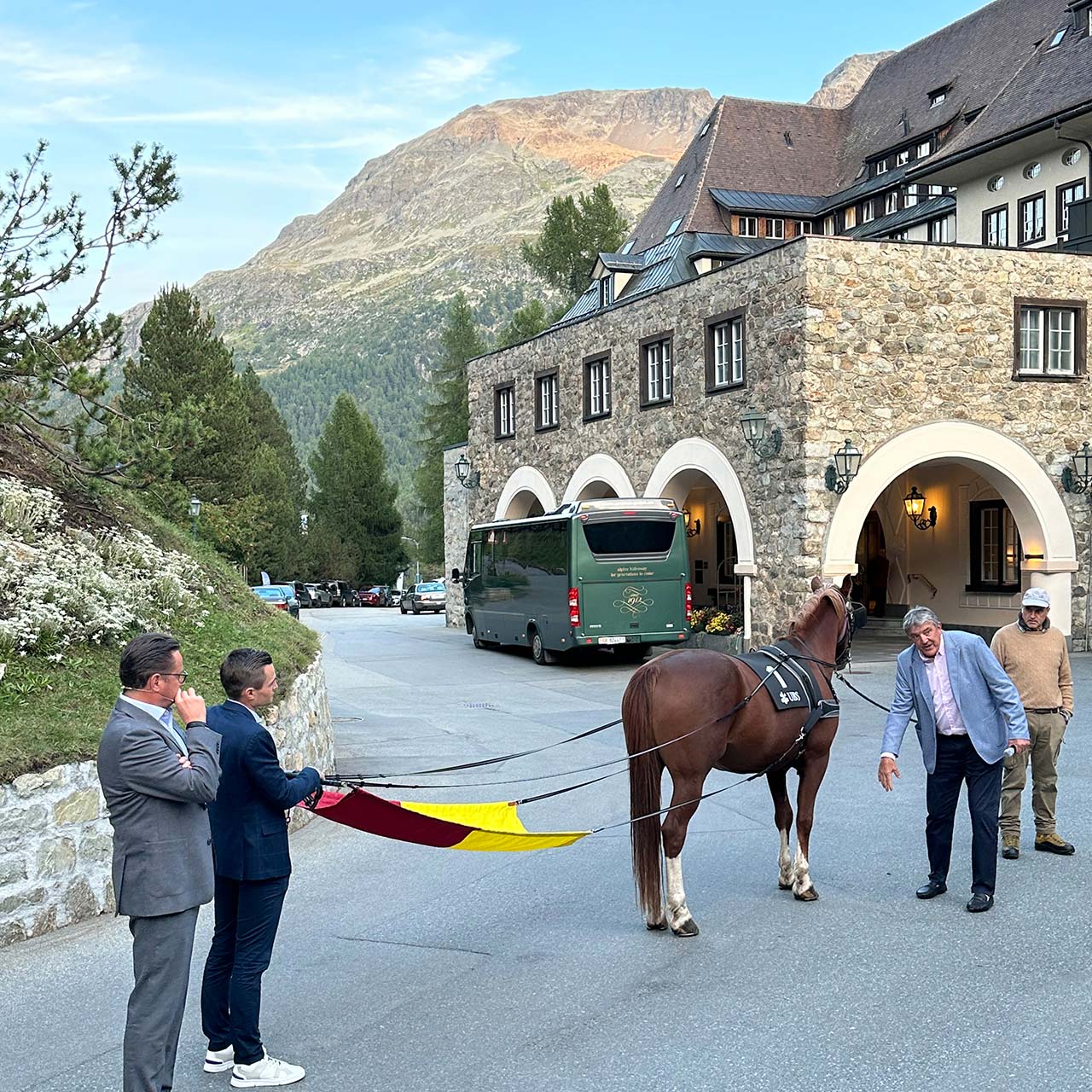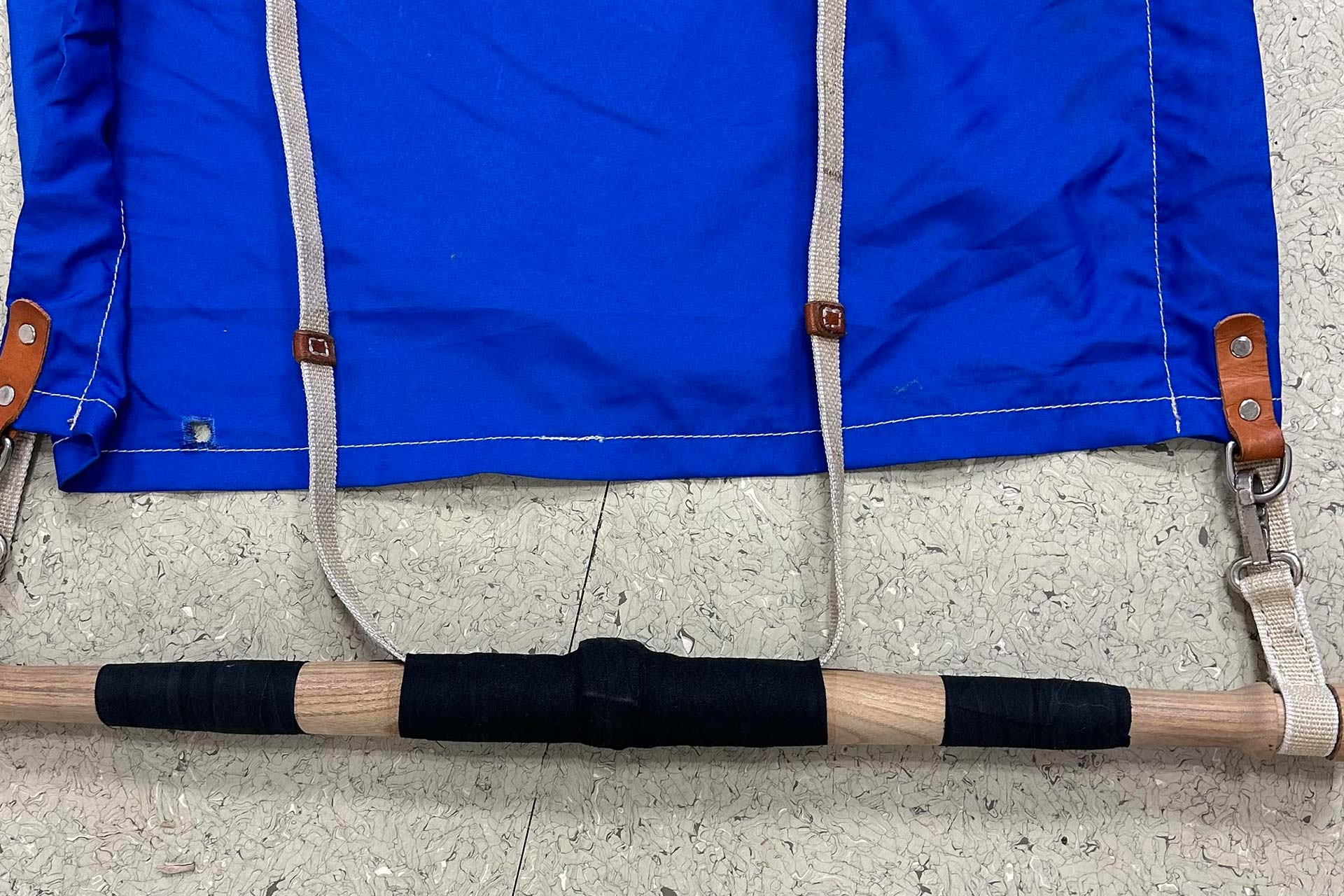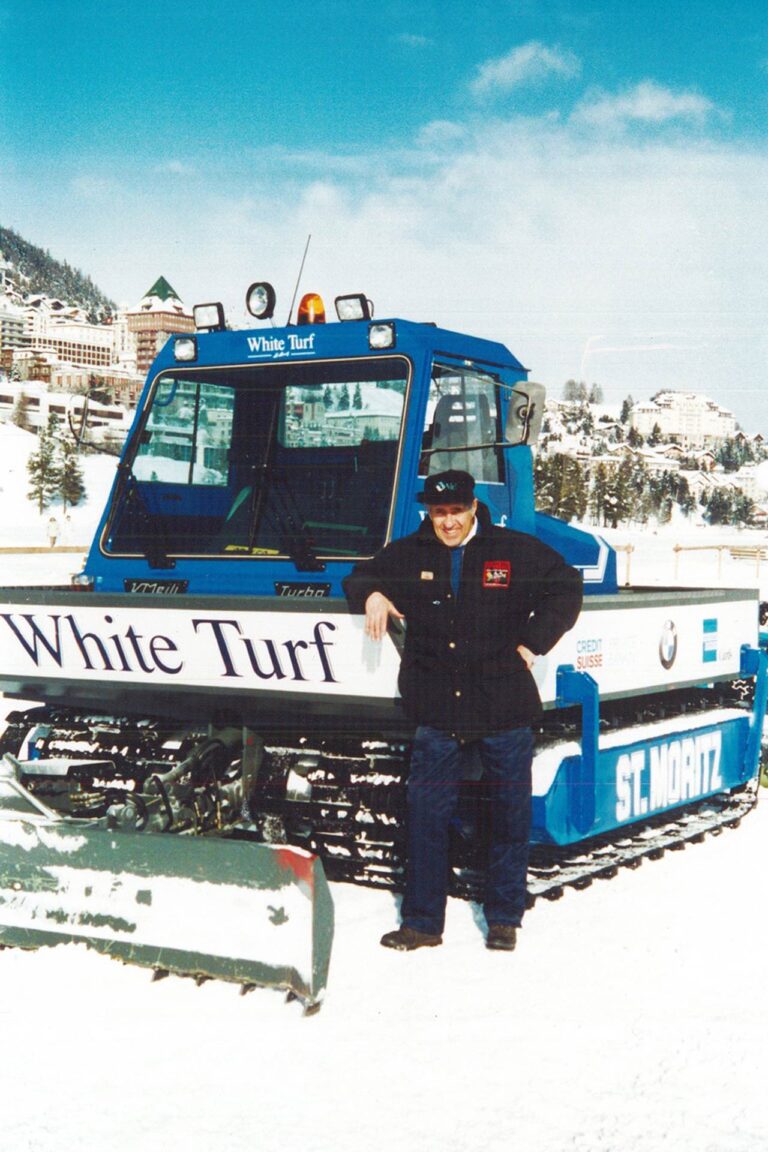INTERVIEW WITH DENNIS SCHIERGEN BY MARKUS MONSTEIN
The biggest innovation for 2025 in Skikjöring will be the introduction of new safety harnesses. In the past, loose horses often created hazardous situations, especially when following teams became entangled in their harnesses. This problem has now been addressed with the development of a groundbreaking safety system. The new harness is designed to “detach” if the driver is no longer connected. Four small explosive charges, placed on the reins and pull lines, allow the harness to fall off, where it can be safely retrieved by the support team.

Dennis Schiergen as the ‘dry-run driver,’ with Thomas Walther (left) and Nicolò Holinger (right).
Looking ahead to 2025, what innovations will there be?
DS: The new safety harness is certainly the most significant change. A lot of time and effort has gone into its development, particularly by the Skikjöring Commission. They made multiple trips to Engelberg to collaborate with the company responsible for designing the harness.
Skikjöring has existed for over 100 years. Who came up with the idea to tackle this issue?
DS: Nicolò Holinger first identified what was needed. Then, together with the experts at Flugsau GmbH, a company specializing in technologies for paragliders and emergency systems, the technical solutions were developed.
How long did the development take?
DS: We began the project in June 2023. The first tests with horses in cold conditions were conducted last winter in St. Moritz. The team was also present at White Turf to observe everything on-site. The key challenges were ensuring the reins and pull lines detached correctly and that the trigger mechanism was reliable. There was even some discussion about using a remote-controlled system, but that idea was dismissed—for good reason! Imagine someone in a control tower accidentally triggering the system—it wouldn’t have been safe.
How exactly does the system work?
DS: There are four small explosive charges located at shoulder height on the horse, with a rein stopper behind them. If the reins detach, the loose parts remain attached to the harness to prevent them from hanging in front of the horse and causing it to step on them. The rear parts simply fall to the ground. The drawbar has been upgraded to include a small control unit, similar to a jet ski safety system, which is physically connected to the driver. When armed, it requires a specific amount of force—only achievable in the event of a fall—to trigger the detachment. Once activated, the explosive charges fire within one second, releasing the harness. The horse can continue galloping without panic, as there are no dangling lines or entanglements, reducing the risk of accidents for other teams.
What happens to the detached harness?
DS: If this occurs at the start—where falls are most likely—the harness will lie on the ground in or near the starting box, where no horses gallop past. If a driver falls during the race, the support team, including medical staff, veterinarians, and security on Ski-Doos, will collect the harness.
What are the costs, and how did sponsor UBS react?
DS: It wasn’t cheap. The development costs exceeded CHF 90,000, and there will be recurring expenses since each activation of the safety capsules incurs a cost. The capsules aren’t exactly budget-friendly, but this is an investment in safety. UBS has been instrumental in supporting this innovation and has also increased prize money. Starting in 2025, there will be three prizes of CHF 20,000 each (previously two prizes of CHF 15,000 and one of CHF 20,000). This substantial increase provides an excellent incentive for participants.
What does the future look like for UBS as a Skikjöring sponsor?
DS: For over 40 years, we enjoyed an exceptional partnership with Credit Suisse. UBS has now taken over this prestigious commitment and serves as the main and title sponsor of the UBS Skikjöring Trophy, as well as a key supporter of the White Turf Family Days. We maintain regular dialogue and are confident that this successful and longstanding partnership will continue well beyond 2025.
What other changes can we expect at White Turf 2025?
DS: Prize money for sprints will be increased to three prizes of CHF 25,000 each, reflecting our commitment to the participants. Sprints have seen lighter participation in recent years, as there isn’t a robust sprinting program in Switzerland. With increased prize money, owners might reconsider acquiring suitable horses. A horse capable of running 1600 meters can now enjoy a more attractive program throughout the year. If it competes three times and wins one race, the Engadine stay is already paid for. We’re also optimistic that the increased stakes will attract international competitors. Skikjöring horses and sprinters are particularly suited for this format, so we prioritized these events for prize increases. Long-term, we aim to boost allocations even further, provided the budget allows.
The number of races remains the same?
DS: Yes, the number of races will remain unchanged. However, we might see some sponsor reshuffling to fund these increases. There’s also the possibility of new sponsors joining, which could bring positive surprises. For the sprinters, we’re considering a Trophy sponsor to enhance the event further. The same applies to trot races, which we hope to elevate in the future. For now, we’re focusing on Skikjöring and sprints, as they offer the most significant potential impact.
What about the infrastructure?
DS: We’re making a few adjustments here as well. For instance, we’re reducing the number of containers on the lake since they heat up under the sun. Instead, we’re switching to tents. Regarding the grandstands, which had to be closed several times in recent years, we’ve divided Grandstand A into two smaller sections, A1 and A2, to reduce the load on specific areas. Additionally, we’re introducing a standing platform near the screen in the inner area, offering 100 exclusive standing places while maintaining a safe distance from the rails and with additional security personnel.
Best wishes for your preparations! We look forward to seeing these positive surprises come to fruition.
DS: Thank you! Time is flying—it’s clear how quickly the pace picks up as the event approaches.
Source: Markus Monstein, (17. December 2024). Interview with Dennis Schiergen: Head Racing from White Turf, new safety harness, Skikjöring and sprints upgraded. www.horseracing.ch.

In use for over 100 years: The traditional drawbar has seen only minor modifications over the decades.


